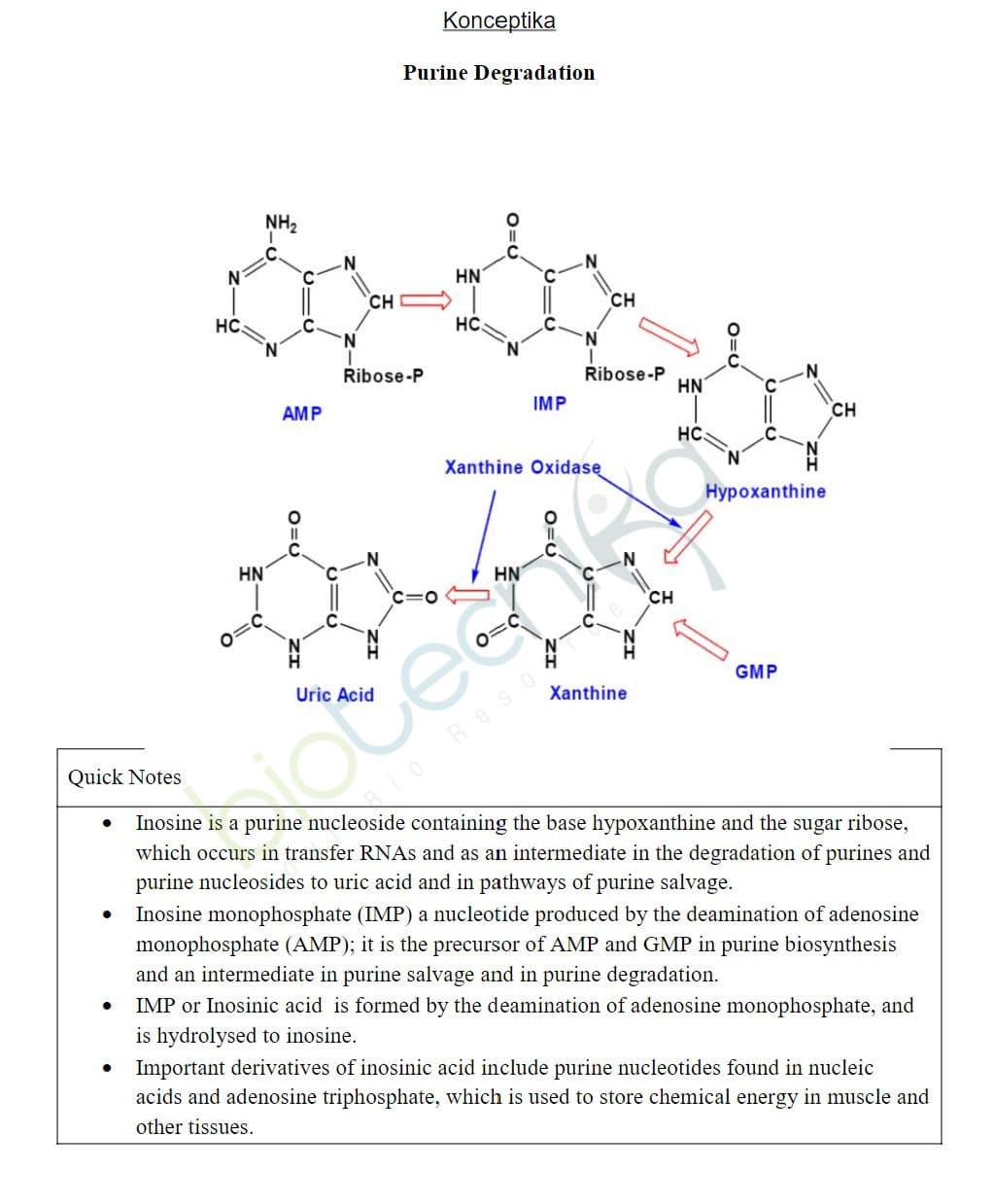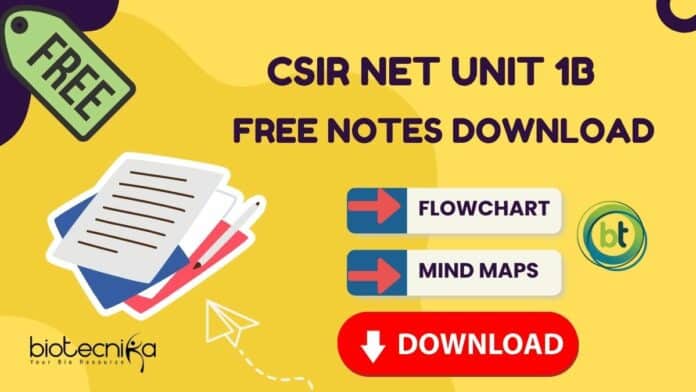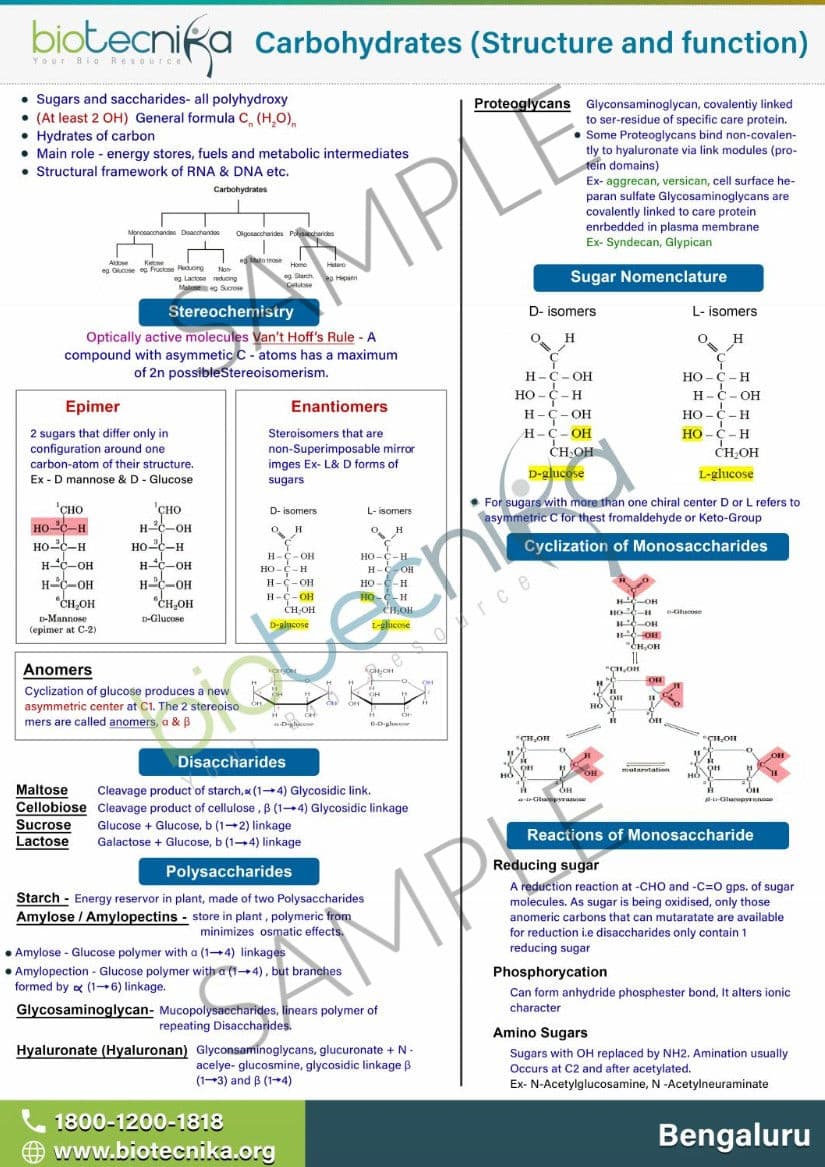CSIR NET Biomolecules Notes – FREE Notes on CSIR NET UNIT 1B Carbohydrates, Lipids, Proteins, Nucleic Acids & Vitamins
Biomolecules are life’s building blocks, and studying their composition, structure, and function is crucial for understanding the complexity of living systems. The main types of biomolecules include carbohydrates, lipids, proteins, nucleic acids, and vitamins. Each molecule has a unique structure and function; studying them can be challenging. Questions from this section are asked in the CSIR NET Life science exam and in other national-level exams like DBT BET, IIT JAM, ICMR JRF & Other state-level exams.
In this article, we will discuss how to study the composition, structure, and function of these biomolecules, including effective methods for breaking down the topics and remembering lengthy concepts.
Carbohydrates
Carbohydrates are organic compounds that play a vital role in energy storage and structural support in living systems. They are made up of carbon, hydrogen, and oxygen, and can be classified into three main types: monosaccharides, disaccharides, and polysaccharides. To study carbohydrates, it is important to understand the different types and their functions.
One effective method for studying carbohydrates is to break down the topics into subtopics. For example, you could start by studying the
basic structure of monosaccharides and how they are linked together to form disaccharides and polysaccharides. Then, you could delve into the different types of polysaccharides, such as starch and glycogen, and their role in energy storage.To remember lengthy concepts, it can be helpful to use mnemonics or visual aids. For example, you could create a mnemonic for the different types of carbohydrates, such as “Monkeys Dig Polysaccharides” (Monosaccharides, Disaccharides, Polysaccharides). Additionally, drawing diagrams and labeling the different parts of a carbohydrate molecule can help reinforce your understanding of the topic.
CARBOHYDRATES KONCEPTIKA LITE SAMPLE – Fill out The Form To Download this sample for FREE
Konceptika Lite is an exclusive copyrighted product of biotecnika which includes flowcharts of all the major CSIR NET Life science topics. Now just take a look at our konceotika flowcharts and understand, revise & recall concepts faster.
Important lecture on Carbohydrates – CSIR NET UNIT 1B Composition, structure and function of biomolecules by Biotecnika Expert Dr. Urmimala
Lipids
Lipids are a diverse biomolecule group that includes fats, oils, waxes, and steroids. They are insoluble in water and are vital in energy storage, cell membrane structure, and signaling. To study lipids, it is important to understand their different types and functions.
One effective method for studying lipids is focusing on their structure and how they relate to their function. For example, you could study the structure of triglycerides, the main type of fat found in the body, and how they are broken down during digestion to release energy. You could also study the structure of phospholipids, which make up the cell membrane, and how they create a barrier between the cell and its environment.
To remember lengthy concepts, it can be helpful to use analogies or real-life examples. For example, you could compare the structure of a triglyceride to a backpack with three pockets, each filled with energy. Additionally, creating flashcards with the different types of lipids and their functions can help reinforce your understanding of the topic.
LIPIDS Lecture For CSIR NET Life Science Exam By Biotecnika – PART 1
To get access to the complete lecture series on Lipids & Detailed CSIR NET Biomolecules Notes , join Biotecnika today. Feel Free to contact us at 1800-1200-1818 or 080-5099-7000 to get more details.
Join us on telegram today to get more such notes & updates
Proteins
Proteins are complex biomolecules that are made up of amino acids and play a crucial role in cell structure, signaling, and enzymatic reactions. They have a diverse range of functions and can be classified into different types based on their structure and function. To study proteins, it is important to understand their basic structure and how it relates to their function.
The best way to study proteins is to focus on the different levels of protein structure. For example, you could study the primary structure, which is the linear sequence of amino acids, and how mutations in this sequence can lead to diseases such as sickle cell anemia. You could also study the tertiary structure, which is the overall three-dimensional shape of the protein, and how it determines the protein’s function.
To remember lengthy concepts, it can be helpful to use mnemonic devices or acronyms. For example, you could create a mnemonic for the different levels of protein structure, such as “SPiT” (Primary, Secondary, Tertiary). Additionally, using flashcards with the different amino acids and their properties can help reinforce your understanding of the topic.
Fill out The Form To Download FREE Notes/ Mind Maps / Flowchart For CSIR NET UNIT 1B – Biomolecules
Nucleic Acids
Nucleic acids are the molecules that store and transmit genetic information in living 
Study nucleic acids by focusing on the structure of nucleotides and how they are linked together to form DNA and RNA. For example, you could study the base-pairing rules, which dictate that adenine (A) pairs with thymine (T) in DNA and with uracil (U) in RNA, and that guanine (G) pairs with cytosine (C).
To remember lengthy concepts, it can be helpful to use visual aids or analogies. For example, you could create a diagram of the double helix structure of DNA, or compare the base-pairing rules to puzzle pieces that fit together. Additionally, practicing with sample questions and problems can help reinforce your understanding of the topic.
Fill out The Form To Download FREE Notes/ Mind Maps / Flowchart For CSIR NET UNIT 1B – Biomolecules
Vitamins
Vitamins are organic compounds essential for normal growth and development in living systems. They are classified into two main types: water-soluble vitamins and fat-soluble vitamins. To study vitamins, it is important to understand their functions and how they are obtained through diet.
One effective method for studying vitamins is to focus on the different types and their functions. For example, you could study the role of vitamin C in collagen synthesis, or the role of vitamin D in calcium absorption and bone health. You could also study the sources of different vitamins, such as citrus fruits for vitamin C and fatty fish for vitamin D.
It can be helpful to remember lengthy concepts using real-life examples or mnemonic devices. For example, you could associate vitamin C with oranges or create a mnemonic for the fat-soluble vitamins, such as “ADEK” (vitamins A, D, E, and K). Additionally, creating flashcards with the different vitamins and their functions can help reinforce your understanding of the topic.
Conclusion
Studying the composition, structure, and function of biomolecules can be challenging, but by breaking down the topics into subtopics and using effective study methods, you can improve your understanding and retention of the material. Mnemonic devices, visual aids, and practice questions can help you remember lengthy concepts. By mastering the study of biomolecules, you will gain a deeper understanding of the complexity of living systems and be better equipped to pursue further studies in biology.
Fill out The Form To Download FREE Notes/ Mind Maps / Flowchart For CSIR NET UNIT 1B – Biomolecules
CSIR NET Biomolecules Notes In Detail.











































Hello, here what will be getting notes for CSIR earth science.
Tell me what’s price for notes+ all questions papers.